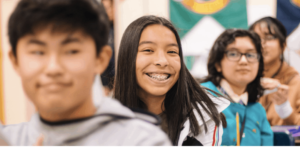Ordering a Teacher: Suggestions from Students (Part 2)

The feedback from Part 1 of “Ordering a Teacher” has been very positive and insightful. The blog has sparked many meaningful discussions, and, in some cases, arguments. All have been fruitful and ultimately positive, however. So, it is with much enthusiasm that I speak on behalf of my brilliant students to deliver the remaining five characteristics of an extremely successful educator…one who appears to be custom-made to order for today’s 21st students. Again, the experts have spoken, and they say today’s educators should be…
#6 Excellent Dancers
“Adaptability or flexibility means being able to change as circumstances require it. It recognizes that life will bring us unforeseen challenges and if we are to honor our values and goals, we must adjust and learn as we go. Adaptability requires a certain willingness to let go, sometimes even grieving unmet expectations or ideas of how things ‘should’ have been.” –WisdomCommons.org
Honestly, this concept is a bit scary and threatening to me. I mean, seriously, have you seen me dance? I make Elaine Benes from Seinfeld look like Michael Jackson performing “Billie Jean” live. All kidding aside, thank goodness this idea of dancing teachers is only a metaphor.
And a powerful one, too.
During a recent discussion about the characteristics of an effective educator mentioned within Part 1, a team of colleagues and I decided the art of teaching can be likened to the art of dancing. This conversation derived from the age-old argument about the ability for teachers to control their classrooms. Thankfully, a number of teachers and I agreed that, although classroom management is vital, classroom control is an illusion. A canard. A lie. There is no such thing as classroom control. Anyone still holding on to this mirage has not seen the clip of A Bug’s Life where the ants finally realize how powerful they are when banded together.
Instead, we decided most successful learning environments are facilitated by awesome dancers who rely on the classroom magic that stems from an interdependent, give-and-take partnership between students and teachers. Think about it. Sometimes educators guide a group of students through a meticulously detailed and choreographed lesson plan and pray students follow, while the very next moment the roles are totally deconstructed with the students adding new moves and twists. This image reminds me to treat my lesson plans as mere frameworks of a house to be constructed later by a team of collaborative carpenters.
If I install foundations replete with standards, engaging and interactive resources, and the flexibility to augment lesson plans with details created, suggested, and organized by students, the results will surely resemble fluid, harmonious, and symbiotic learning at its finest. Other times, class is like a synchronized line dance with all students following a rock-solid, gamified lesson plan. Although students are always on different levels of learning, these well-planned learning activities can bring students’ diverse talents and skills together to create something much larger than themselves.
One thing is definitely for sure. According to the students, learning should rarely resemble the kind of dance illustrated by John Travolta in Saturday Night Fever. Yeah, I know. It is an amazing scene from an amazing movie, and, truthfully, I wish I could be as cool as he was dancing under a multi-colored strobe light on multi-colored, tiled floor while strutting around with butterfly collars and snug-fitting polyester. Heck, the paint-can walk at the beginning of the movie was enough to make me long for coolness.
But that’s exactly my point. The students say it is not about me. It is not about the power lecturers or the know-it-all sages on the stage. It is not about the teachers. It is about the dance created by all parties involved.
#7 Energetic
“The world belongs to the energetic.” –Ralph Waldo Emerson
Let’s face it. There is no comparison between the lethargic and monotone teacher in Ferris Bueller’s Day Off and the energetic and inspirational Mr. Keating in Dead Poets Society. There is no way students will be enthusiastic about learning if the teachers show no excitement or energy for teaching.
Students were in agreement that educators who drag themselves around the classrooms and show no signs of zest for their professions ultimately zap the life out of their students. I thought it was quite interesting that many students said teachers who exhibit this type of behavior actually establish classroom atmospheres that mirror this lack of energy and overall indifference.
No students were saying teachers need to jump on desks and tables, a la Ron Clark. All that is needed is a little excitement for learning and genuine concern and love for the students. The energy will effortlessly flow then.
#8 Aware
“What is necessary to change a person is to change his awareness of himself.” –Abraham Maslow
Students often paint a gloomy picture of teachers who are extremely unaware. They say this lack of awareness keeps students from connecting, and oftentimes respecting, According to these overlooked experts, unsuccessful teachers are unaware of:
- Student’s needs, strengths, weaknesses, talents, passions, future ambitions, homelife and fears
- Their own strengths, weaknesses, talents, and fears
- Current modes of connecting to other professionals
- How powerful a heart-to-heart and face-to-face conversation with students can be
- Engaging teaching strategies
- Trends in educational technology
- Their tone and condescending manner when speaking to students
- How their preceding reputations establish negative expectations before students ever enter the classrooms
- How awesome their classes could be if the students were asked their opinions
#9 Curious
“It is a miracle that curiosity survives formal education.” –Albert Einstein
This quotation just about sums it all up. It seems so many educators are unwilling, or maybe just downright scared, to deviate the slightest bit from the learning blueprint, the unbending lesson plan. This rigidity often squelches students’ questions. As one student put it so well, “It seems teachers want to fill our brains with facts when all we want to do is discover the facts of who we are and what we can accomplish through questioning and creating.”
Teachers who ask questions, pose challenges, and demonstrate a genuinely inquisitive nature spark this same curious mindset within their students. One such teacher who ignited a passion for learning was one who I never met…Steve Irwin. This ceaseless ball of energy captivated a world of animal lovers, or soon-to-be animal lovers, by simply expressing his awe for all living creatures. Even when things didn’t go his way, Steve Irwin remained curious. Take a look at this video and hear the curiosity and wonder in his voice. It nearly makes me want to stare eye-to-eye with this beautiful lizard.
#10 Creative
“The creation of something new is not accomplished by the intellect but by the play instinct acting from inner necessity. The creative mind plays with the objects it loves.” –Carl Jung
I know, I know. Expecting teachers to be creative all the time adds pressure to the always challenging profession, but injecting creative twists to old lesson plans through gamification, interactive learning structures, passion-based learning projects or by simply redesigning traditional classrooms could be just the pressure relief needed. After all, a classroom of engaged and passionate learners is the most effective form of classroom management.
Teachers don’t necessarily need to be creative, they just need to provide opportunities for children to be creative. #edcampsfbay #satchatwc
— Ed (@Primary_Ed) August 10, 2013
As this embedded tweet suggests, teachers who feel the DNA gods failed to give them the creative genes necessary to wow a class of learners can simply remember to “create” an environment that allows students to construct authentic work.
Well, quite frankly, the students have spoken. I sure have tried to listen. Take one last look at all ten and ask yourself, “What would my students say about me?”
If I am truthful right now, I better to get to work.
If I need any help, I’ll ask the students to point the way.








0 Comments
Leave a Comment
Your email address will not be published. All fields are required.